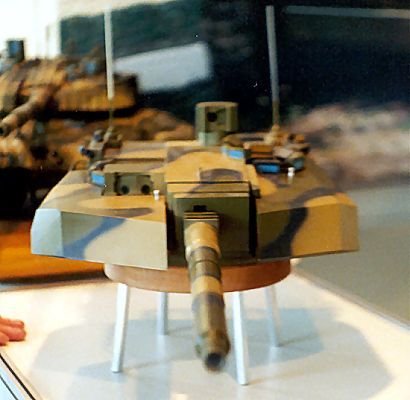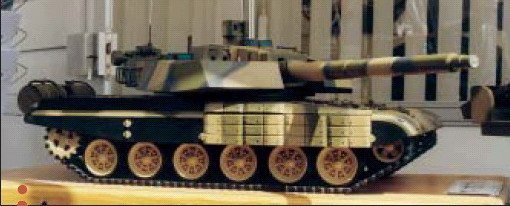You are using an out of date browser. It may not display this or other websites correctly.
You should upgrade or use an alternative browser.
You should upgrade or use an alternative browser.
Alternative History Armoured Fighting Vehicles Part 3
- Thread starter Claymore
- Start date
- Status
- Not open for further replies.
Funny how these things go! 🤣😂🤣
Simple solution.


The soviets were great fans of this tactic.

Ah yes, Tankers favorite bio-ablative armor!
Randy
Yes and no, in that I'm not sure the original turret could fit-but the T21 turret designed for Slovakia did:A quick question, would the Leclerc turret fit the T-64 or T-72?



The turret differs in that it was lightened to 15t from 18t by reducing the bustle autoloader capacity to 18 rounds instead of 22 and decreasing base frontal arc protection, among other changes. Offered to Poland as well.
Last edited:
So it fits but might be to heavy for the suspensionYes and no, in that I'm not sure the original turret could fit-but the T21 turret designed for Slovakia did:



The turret differs in that it was lightened to 15t from 18t by reducing the bustle autoloader capacity to 18 rounds instead of 22 and decreasing base frontal arc protection, among other changes. Offered to Poland as well.
Ah ha, I know where I went wrong: after doing some actual research I realize I meant the QF95mm howitzer and not an American 105. I assumed some of the Sheridans would have been retained with a big HE round as bunker busters alongside the M3s, but if Japan's busting out some heavier armour that makes the 17pdr worth it, I'm happy to stand corrected.As highlighted in the backstory above, the 105mm howitzer was never that popular in British service as it was not a standard production calibre
Didn't during WW2 one country (I forget which one) tied sleds to the back of tanks for infantry to ride on?
What if this was taken a step further and tanks just towed armored sled or wagons instead of the development of the APC?
It's certainly a cheaper option (although definitely less effective).
What if this was taken a step further and tanks just towed armored sled or wagons instead of the development of the APC?
It's certainly a cheaper option (although definitely less effective).
I think I saw this in multiple countries and vehicle models: russians, finns, germans...Didn't during WW2 one country (I forget which one) tied sleds to the back of tanks for infantry to ride on?
What if this was taken a step further and tanks just towed armored sled or wagons instead of the development of the APC?
It's certainly a cheaper option (although definitely less effective).
Driftless
Donor
Didn't during WW2 one country (I forget which one) tied sleds to the back of tanks for infantry to ride on?
What if this was taken a step further and tanks just towed armored sled or wagons instead of the development of the APC?
It's certainly a cheaper option (although definitely less effective).
I think I saw this in multiple countries and vehicle models: russians, finns, germans...
Probably most useful in the second wave, or reserves for an attack. Gets the infantry forward to help sustain an attack without having them slog through deep snow.
Even the Brits did it at times - one of the post DDay attacks - possibly Goodwood but I'm not able to check my books just now. However, riding on Churchills may not be much faster than walking.The soviets were great fans of this tactic.

Armour that complains!Ah yes, Tankers favorite bio-ablative armor!
Randy
Now a bit more seriously, they are kinda useful in case of an ambush, they have a lot more visibility than the tank crew, and a very high interest in not being ambushed.Armour that complains!
Faster? Maybe not by much.Even the Brits did it at times - one of the post DDay attacks - possibly Goodwood but I'm not able to check my books just now. However, riding on Churchills may not be much faster than walking.
But Soldiers are soldiers and have always been soldiers, and if they can get out of walking, they will.
The thing that everyone is missing (intentionally or not) is that tank riding infantry are hideously vulnerable to artillery, mortar and even sustained Mg fire. That’s why mobile infantry need their own armoured protection and ideally with overhead cover. Why did the Soviets use this technique so frequently in the attack? They had warm bodies to spare, the risk and end result was worth the losses. Not something the Western Allies were in favour of unless said tank riders were well away from the dangers of the front lines.
The thing that everyone is missing (intentionally or not) is that tank riding infantry are hideously vulnerable to artillery, mortar and even sustained Mg fire. That’s why mobile infantry need their own armoured protection and ideally with overhead cover. Why did the Soviets use this technique so frequently in the attack? They had warm bodies to spare, the risk and end result was worth the losses. Not something the Western Allies were in favour of unless said tank riders were well away from the dangers of the front lines.
My understanding was that "riding on tanks" was deemed safer than walking through minefields while under longer sustained artillery fire.....so although out in open there was less time under artillery fire and exponentially better protection from land mines.
Last edited:
My understanding was that "riding on tanks" was deemed safer than walking through minefields while under longer sustained artillery fire.....so although out in open there was less time under artillery fire and exponentially better protection from land mines.
Tank desant is a tactic, where infantry soldiers ride into an attack on tanks, then dismount to fight on foot in the final phase of the assault. Note that this differs from infantry troops merely riding on tanks as a form of ad-hoc transportation.
Tank desant troops were infantry trained in the tactic in order to offer small-arms support in suppression of enemy anti-tank weapons or enemy infantry using anti-tank grenades. Within Soviet doctrine, use of tank desant was only prescribed within the first kilometre of the forward edge of the combat area for only the simplest of tactical mission objectives, since the circumstances would be difficult for the troops engaged.
Realistically, riding on tanks during actual combat is very dangerous. Tank riders are very vulnerable to machine gun and high explosive fire, and the high silhouette of most tanks would draw enemy fire, however, smoke and covering fire may be used to reduce the hazards. Tank riding is mostly used when troops need to move faster than is possible on foot and there is a shortage of motor transport or armoured personnel carriers.
Today, tank desant is considered a wasteful and human-costly improvisation, which, in the opinion of some, was adopted by the Red Army because they failed to appreciate the problem of tank–infantry cooperation. Nowadays, this tactic is very rare (outside of dire emergencies) in well-equipped armed forces, with front-line troops usually riding in armoured personnel carriers or infantry fighting vehicles.
.
- Status
- Not open for further replies.
Share: